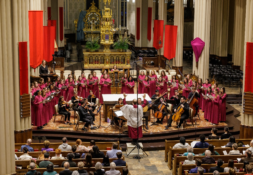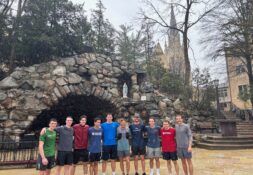A rocky start to an iconic Notre Dame tradition
The Notre Dame Bagpipe Band is a now-iconic fixture of game days, but it is a relatively new tradition. Founded in 1949, the band only started marching into the stadium in 2011.
According to the Bagpipe Band’s website, bagpipes were first introduced in 1949 when the Irish Guard began marching with the Notre Dame marching band. Originally formed as a bagpiping unit, the Irish Guard became purely ceremonial in 1954, as it was soon discovered that bagpipes are not fit for a marching band. The cold air of a fall day in South Bend made moisture condense on the reeds, deadening the sound of the pipes, and the relatively few number of pipers were drowned out by the roar of the stadium.
It wasn’t until 1987 that bagpipes were played throughout campus again. Paul Herren, a sophomore at the time, was an “avid piper” and formed an official student club, which brought the bagpipes back to campus. However, now unaffiliated with the Irish Guard, the band was not allowed to wear the Notre Dame tartan. Instead, the bagpipers tied bed sheets around their waists in place of kilts as they performed at small events.
In 2000, a number of freshman pipers arrived on campus, and the band continued to grow. By the fall of 2001, the band marched on campus for the first time since 1954, and mid-season the band acquired used kilts from the Irish Guard. It was during this football season that the band also added their own drum line.
In 2011, former head football coach Brian Kelly asked the Bagpipe Band to march the football players into the stadium. Now in their own tartan kilts, glengarry bonnets, and black doublets, the Notre Dame Bagpipe Band can be found playing throughout campus on home game days, as well as in the Chicago St. Patrick’s Day Parade as they play on the boats that dye the Chicago River green.
Students and faculty do not have to have any piping experience to join the band, as “The band has a dual mission of performing with the pipes and teaching other students how to play them. The band provides most of the bagpipes, drums, and uniforms to its members.”
Fifth-year architecture student Jack Harrington, who has been Pipe Major since the second semester of his freshman year said in an interview with the Rover that his favorite memory of the band has been teaching his friends to play the pipes: “By the end of my freshman year, our membership roster was myself and our two advisors. We realized that if we don’t start finding more pipers and drummers soon, there will be no more ND Bagpipe Band … Rather than wait for the next admissions cycle, I decided to start teaching anyone who wanted to learn to play the pipes. My sophomore year I taught five freshmen to play, then junior year another four. Now we’re up to just under 20 performing members, most of whom I taught to play the pipes from scratch.”
He continued, “Over the last few years I’ve been able to see all their efforts of learning week after week after week pay off. It’s not easy to play the highland bagpipes, let alone learning to play while also being a full-time student here. But they do it, and they do it well. So what’s my favorite memory as a piper here at ND? Seeing the look of pride on my friends’ faces when they perform their first solo performance in front of hundreds of people, knowing the work they put in to get there.”
Harrington is one of five children, all of whom played the pipes after being introduced to the instrument in a unique way: “After moving to Colorado Springs, my siblings and I had far too much time on our hands. After watching a particular episode of the TV show How It’s Made, where they showed how they make highland bagpipes, we figured, ‘Why not?’ That was 12 years ago now.”
Harrington shared that the band has an official practice for four hours every week in Washington Hall, though they practice outside when they can. He said, “We have an informal rule that if you hear pipes on campus, any other member can (and should) grab their pipes and go join. We have mini jam-sessions all the time where we come up with cool harmonies and play our favorite songs for a little while … One of my favorite things to do is to hear pipes being played in the distance on campus and try to figure out who’s playing—everyone’s playing style is just a little bit different, and sometimes you can pick up on it from a mile away.”
The distinctive noise of highland bagpipes is not only noticed by fellow bagpipers, though. Sophomore Julianna Lopez told the Rover, “I love hearing the bagpipes while I do homework. It always reminds me of how lucky I am to be a part of the Irish family! The view of the Dome and listening to the bagpipes from my room in Breen-Phillips are constant, happy reminders of being a Notre Dame student.”
She continued, “My grandpa passed away the day before I moved out to Notre Dame, and he loved playing the bagpipes, so every time I hear them I think of him!”
As the weather gets warmer in South Bend, the bagpipers can be heard throughout campus practicing for next year’s football season. Next fall, they can be found performing in front of the Main Building for four hours before every home game.
Elizabeth Hale is a sophomore studying political science. She has often been told that she sounds like “bagpipe skirl” when she sings, and she is starting to think that it is not a compliment. Send comments and questions to ehale@nd.edu.
Photo Credit: Notre Dame bagpipe band website
Subscribe to the Irish Rover here
Donate to the Irish Rover here





